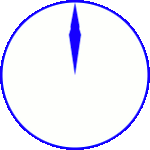Puzzle: All in the Timing
25 July 2011Assume that you have a perfect twelve-hour clock, with an hour hand and minute hand, each of which moves continuously.

At certain times of day, the minute hand and hour hand will be pointed in exactly opposite directions. The obvious case is that of six o'clock. What are the other times? (Specify your answers precisely, rather than rounding to the nearest minute or second.)
At certain times of day, the minute hand and hour hand will be pointed in exactly the same direction. The obvious case is that of twelve o'clock. What are the other times? (Again, specify your answers precisely.)
(The actual mathematics here is very simple. And the insight that would allow one to answer the first question should apply with very minor modification to the second one.)
Tags: mathematics, puzzles


One Hand Chasing The Other,
Let "a" denote arc-length, the clock face being divided into 12 units of a.
Let the position of a given clock hand be specified in units of a, where displacement of units of a denotes the distance from the 12:00 position (aka 0*a).
Let "r" denote the constant rate of change between the position of the hour hand and minute hand. Let r=1/12.
* The hour hand starts at position 1*a. By the time the minute hand reaches 1*a, the hour hand has advanced by r*a.
* Given the hour hand advanced to (1*a + r*a), the minute hand must cover at least that span it if it so ever meet the hour hand.
* In the time it takes to advance the minute hand to (1*a + r*a), the hour hand has moved again, this time to (1*a + r*a + r*r*a).
* The minute hand must again cover the new (but increasingly smaller span) ... in which time the hour hand has advanced to (1*a + r*a + r*r*a + r*r*r*a)
* Again, the minute hand must cover that new span, so construct an expression for the n-th span the hour hand must sweep.
* Let the expression A = a(1 + r + r^2 + r^3 + ... + r^n) denote the arc traversed by the minute hand, as it approaches the hour hand, for the n-th span.
* Increase n, to infinity (but not beyond!), and note that the power series converges, by the power rule (as the denominator of r is greater than 2).
* Thus the limit of A, as n goes to infinity, is the arc at which the minute hand meets the hour hand in the interval (1:00,2:00].
A similar general method may be used for the other intervals, with a small adjustment to the original position of the hour hand.
For additional kicks, one may also consider the case where one had a clock with only two hours and minutes, 0 and 1. The rate of change of hours to minutes is r=1/2, and we again ask when the hour hand meets the minute hand.
The expression A = (0 + r + r^2 + r^3 + ... + r^n) as n goes to infinity still holds (the starting position is 0 in the interval in question), and it becomes:
A = (0 + 0.5 + 0.5^2 + 0.5^3 + ... + 0.5^n), which converges to 1.
In binary starting from (H,M) = (0,0), the possible times are: (0,0), (0,1), (1,0), and then (1,1) where H equals M at clock-hand position 1.
It was a welcome surprise to find Achilles chasing the tortoise here!
I would note that, without loss of generality, your a can be set equal to 1.
In any case, I acknowledge that your remarks about the solution are perfectly correct.
It is possible effectively to reduce each of these problems to a system of two equations and of two unknowns. The variables in each case are
in each case measured from that at 12:00.
The first equation in each case is
Very simply, the minute hand moves twelve times as fast as the hour hand, and its angle is thus always 12 times that of the hour hand. (But note that, with the arithmetic of angles, θ = θ + 360°.)
The second equation of the first problem is
where n is an integer; which is to say that, when the minute hand is pointing in the opposite direction of the hour hand, once one has subtracted any complete sweeps (360°) of the minute hand around the dial, it is 180° ahead of the hour hand.
A little algebra, and the first system becomes
θm = θh + 180°
Plug-in n = 0, 1, … , 10, and you've the answer in angles. (At 11, you'd just be repeating yourself.)
Note that the change from each θm to the next (and from each θh to the next) is 360°/11. Rather than converting each pair of angles to a time, just divide the number of minutes in an hour by 11, and use common-sense for the hour!
The second equation of the second problem is
which is to say that, once one has subtracted any complete sweeps (360°) of the minute hand around the dial, it has the very same angle as has the hour hand.
A little algebra, and the second system is
θm = θh
Plug-in n = 0, 1, … , 10, and you've the answer in angles.
Again note that the change from each θm to the next (and from each θh to the next) is 360°/11, so just divide the number of minutes in an hour by 11, and use common-sense for the hour.